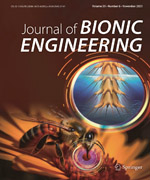As the basis of flight behavior, the initiation process of insect flight is accompanied by a transition from crawling mode to flight mode, and is clearly important and complex. Insects take flight from a vertical surface, which is more difficult than takeoff from a horizontal plane, but greatly expands the space of activity and provides us with an excellent bionic model. In this study, the entire process of a butterfly alighting from a vertical surface was captured by a high-speed camera system, and the movements of its body and wings were accurately measured for the first time. After analyzing the movement of the center of mass, it was found that before initiation, the acceleration perpendicular to the wall was much greater than the acceleration parallel to the wall, reflecting the positive effects of the legs during the initiation process. However, the angular velocity of the body showed that this process was unstable, and was further destabilized as the flight speed increased. Comparing the angles between the body and the vertical direction before and after leaving the wall, a significant change in body posture was found, evidencing the action of aerodynamic forces on the body. The movement of the wings was further analyzed to obtain the laws of the three Euler angles, thus revealing the locomotory mechanism of the butterfly taking off from the vertical surface.



